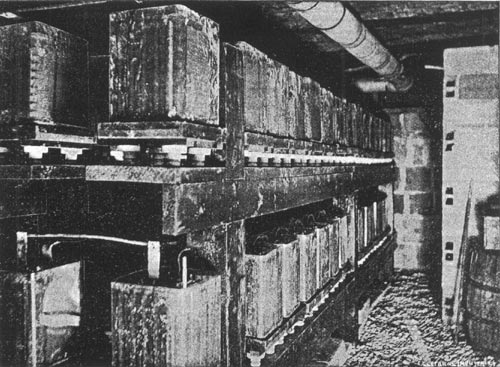[Trade Journal]
Publication: Electrical Industries
Chicago, IL, United States
vol. 5, no. 3, p. 79, col. 1-2
Storage Batteries in the Masonic Temple.
There is no doubt that at no very distant date the storage battery will occupy an important place in the utilization of electric energy. As the capabilities and limitations of the storage battery are more fully understood and knowledge of its use is more widely disseminated, the position it should occupy will open up to it. There are a number of places where the storage battery is now used to advantage and others, which at present are but experiments, will soon be placed on the list.
A large proportion of the office buildings erected in Chicago during the past few years are equipped with their own electric lighting plants. In these buildings lights are required in considerable number until late in the evening, after which only such lights as the janitors and watchmen use are required. To keep steam up and operate a dynamo would involve a large expense proportionate to the service. To supply these lights, storage battery plants have been installed in several buildings which are charged during the day or in the early evening in connection with the operation of the large amount of machinery required in such buildings. The battery plant supplies current for the lights until such a time as it may be necessary to start the dynamos. They require no attendant while in use so that after the machinery is shut down, the owners are under no expense for engineers or attendants.
| |||
| Storage Batteries in the Masonic Temple. |
A storage battery plant for the purpose similar to the above has been installed in the Masonic Temple by the American Battery Company of Chicago. It is used for lighting the basement and the darker portions of the building during a part of the day and after the machinery is shut down at night. From 25 to 100 lights are thrown on the battery the latter number being but seldom required and then only for a short time. The battery consists of 58 cells connected in series, all of which however are not used all the time, a few extra cells being kept ready should it be desirable to change a cell or should the battery be nearly run down and more cells be required to keep up the voltage. A separate room is provided for the battery which is arranged on a substantial frame in two tiers, the fame [sic] frame is insulated from the ground by heavy wooden blocks and the individual cells are insulated by porcelain supports. The cells are in glass jars of more than the usual size. The capacity of each cell is 350 amperes at a 25 ampere rate. The cell is 9 3/4 by 9 by 13 1/2 inches and weighs 130 pounds. The plates are separated by hard rubber insulating bars or combs which keep all plates the proper distance apart. The plates are manufactured in the manner pursued by the American Battery Co. The jars being much larger in proportion to the plates than usually employed, a much greater amount of solution is held where it can be called upon if needed in charging and discharging the cell.
The battery is charged from a Mayo iron clad dynamo at 140 volts having a capacity of 65 amperes. The dynamo is belted to a friction clutch pulley on one of the main shafts in the engine and dynamo room and is usually started soon after the other dynamos. The battery is put into use at 12 o'clock, midnight and is in use some days as late as 4 o'clock the next afternoon, the time depending on the weather and the load carried. One of the first accidents in the history of the building occurred since this battery was put in. The accident extinguished the lights in the building and the current from the battery furnished light while the trouble was being found and repaired. Its use on this occasion saved a great deal of annoyance and permitted the quick repair and starting of the plant.
The basement of the building is being fitted up for several firms who will occupy it for restaurants, safety vaults, etc., purposes which will require a much larger amount of light than at present. To carry this load after midnight and during the day the storage battery plant will probably be increased. To persons interested in the practical use of the storage battery a full and complete report of the operation of this plant will be full of interest.

